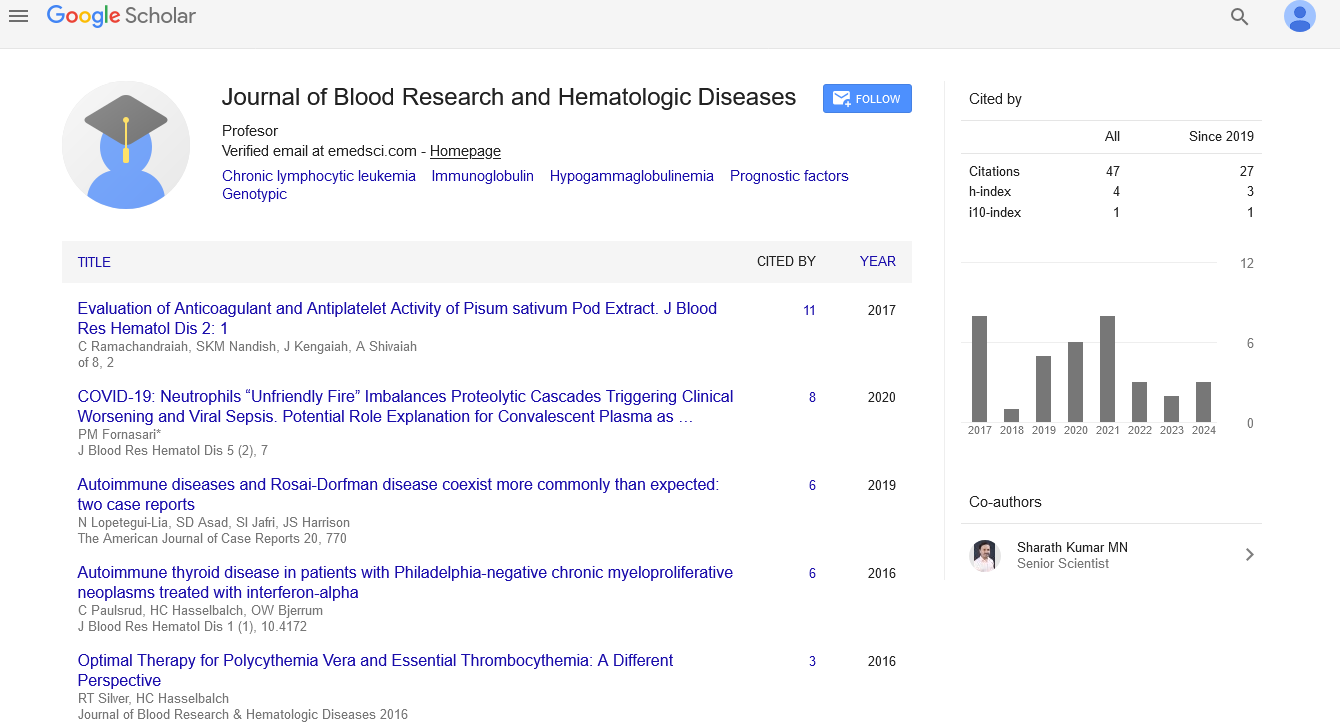Commentary, J Blood Res Hematol Dis Vol: 10 Issue: 1
Why Anemia Occurs Following Blood Loss: Exploring the Underlying Causes
Danadford Smihony*
Department of Cell Systems and Anatomy, University of Texas Health Science Center, San Antonio, United States of America
*Corresponding Author:Danadford Smihony
Department of Cell Systems and Anatomy, University of Texas Health Science
Center, San Antonio, United States of America
E-mail:danadfordsm@gmail.com
Received date: 24 May, 2024, Manuscript No. JBRHD-24-137150;
Editor assigned date: 27 May, 2024, PreQC No. JBRHD-24-137150(PQ);
Reviewed date: 11 June, 2024, QC No. JBRHD-24-137150;
Revised date: 10 March, 2025, Manuscript No. JBRHD-24-137150(R);
Published date: 17 March, 2025, DOI: 10.4172/jbrhd.1000223
Citation: Smihony D (2025) Why Anemia Occurs Following Blood Loss: Exploring the Underlying Causes. J Blood Res Hematol Dis 10:1.
Description
Anemia is a condition characterized by a deficiency in the number of Red Blood Cells (RBCs) or hemoglobin in the blood, leading to reduced oxygen-carrying capacity. One of the most common causes of anemia is blood loss, which can occur acutely due to trauma or surgery, or chronically from conditions such as gastrointestinal bleeding or menstruation. In this article, we delve into the underlying causes and mechanisms through which blood loss contributes to the development of anemia.
Understanding anemia and blood loss
Anemia affects millions of people worldwide and can manifest in various forms, depending on its underlying cause. While deficiencies in nutrients like iron, vitamin B12, or folate can also lead to anemia, blood loss remains a significant contributor, particularly in cases of iron-deficiency anemia.
Types of blood loss leading to anemia
Blood loss can be categorized into acute and chronic forms, each presenting unique challenges and implications for anemia development:
Acute blood loss: Acute blood loss occurs suddenly and may result from injuries, surgical procedures, or childbirth complications. The rapid loss of blood volume can lead to a significant decrease in oxygen-carrying capacity, triggering symptoms of anemia such as fatigue, weakness, and shortness of breath.
Chronic blood loss: Chronic blood loss occurs gradually over an extended period and is commonly associated with conditions like gastrointestinal ulcers, colorectal cancer, heavy menstrual bleeding, or chronic inflammatory diseases. Chronic blood loss may not always be immediately noticeable but can lead to persistent iron deficiency and anemia if left untreated.
Mechanisms of anemia following blood loss
The development of anemia following blood loss involves several interrelated mechanisms:
Iron deficiency: Iron is essential for the production of hemoglobin, the protein in RBCs responsible for binding and transporting oxygen. Acute or chronic blood loss leads to a depletion of iron stores in the body, impairing hemoglobin synthesis and resulting in iron-deficiency anemia.
Erythropoietin response: In response to decreased oxygen delivery due to blood loss, the kidneys release erythropoietin, a hormone that stimulates the production of RBCs in the bone marrow. While this response aims to restore normal blood oxygen levels, it may not be sufficient to compensate for ongoing blood loss or iron deficiency, contributing to anemia.
Hypovolemia and tissue hypoxia: Significant blood loss can lead to hypovolemia (low blood volume) and impaired tissue perfusion, resulting in tissue hypoxia (oxygen deficiency). Chronic tissue hypoxia can further exacerbate the production and survival of RBCs, perpetuating anemia and affecting overall organ function.
Diagnostic evaluation and management
Diagnosing anemia following blood loss typically involves a comprehensive evaluation, including medical history, physical examination, blood tests (complete blood count, iron studies), and imaging studies (such as endoscopy or imaging for suspected internal bleeding).
Treatment approaches
Iron supplementation: For iron-deficiency anemia resulting from blood loss, oral or intravenous iron supplements may be prescribed to replenish iron stores and support hemoglobin synthesis.
Blood transfusion: In cases of acute severe blood loss or symptomatic anemia, blood transfusions may be necessary to rapidly restore blood volume and oxygen-carrying capacity.
Management of underlying cause: Treating the underlying cause of blood loss, such as surgical intervention for bleeding ulcers or tumors, is crucial to prevent recurrent anemia.
Complications and prognosis
Untreated or chronic anemia due to blood loss can lead to serious complications, including cardiovascular strain, cognitive impairment, and reduced quality of life. Prompt diagnosis and management are essential for improving outcomes and preventing long-term sequelae associated with anemia.
Research and advances
Ongoing research focuses on improving diagnostic tools for identifying and monitoring anemia, developing targeted therapies for specific types of anemia, and understanding the molecular mechanisms underlying iron metabolism and erythropoiesis.
Conclusion
In conclusion, anemia following blood loss is a common yet treatable condition that significantly impacts overall health and wellbeing. Understanding the underlying causes and mechanisms involved in anemia development is essential for accurate diagnosis, effective management, and improved patient outcomes. By addressing the root cause of blood loss and restoring normal hemoglobin levels through appropriate interventions, healthcare providers can mitigate the impact of anemia on individuals' health and quality of life.
 Spanish
Spanish  Chinese
Chinese  Russian
Russian  German
German  French
French  Japanese
Japanese  Portuguese
Portuguese  Hindi
Hindi 